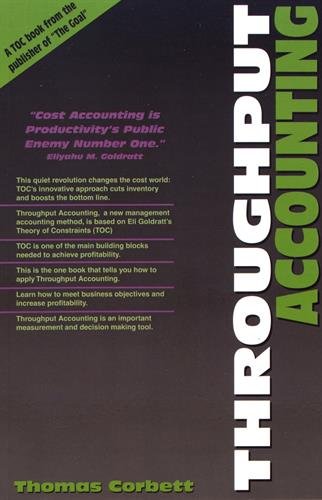Thu, 07 Sep 2017
Cost Accounting as a Poorly Defined Constrained Optimization Model
I recently read The Goal, a business novel that introduces the Theory of Constraints as a toolset for managing a business in order to "more money now and in the future". One of the criticisms the book makes of the way businesses are often run is that their use of cost accounting to guide decisions fails to maximize the amount of money the business can make. An alternative called throughput accounting is proposed, but after having completed The Goal, I didn't have a clear understanding of how and why cost accounting fails.
 So I bought Throughput Accounting to dig
in deeper. The book starts with a great example of a simple decision made
using cost accounting.
So I bought Throughput Accounting to dig
in deeper. The book starts with a great example of a simple decision made
using cost accounting.
A factory makes mens and womens shirts. To make a shirt, you need some raw materials, plus the labor to cut fabric and sew fabric.
- Womens shirts sell for $105. Mens shirts sell for $100.
- Raw materials for womens shirts cost $45. Raw materials for mens shirts cost $50.
- Womens shirts require 2 minutes of cutting and 15 minutes of sewing.
- Mens shirts require 10 minutes of cutting and 10 minutes of sewing.
- Market demand is such that we can sell 120 womens shirts per week at $105 and 120 mens shirts at $100.
- We only have 2,400 minutes (1 person at 40 hours per week) of cutting time, and 2,400 minutes of sewing time available each week.
- Labor costs for sewing and cutting are the same.
- Operating expenses are $10,500/week, to pay salaries, rent, etc.
| Womens | Mens | |
| Price | $105 | $100 |
| Raw Materials | $45 | $50 |
| Cutting Time | 2 minutes | 10 minutes |
| Sewing Time | 15 minutes | 10 minutes |
| Total Time | 17 minutes | 20 minutes |
| Weekly Demand | 120 shirts | 120 shirts |
Making all 120 womens shirts and 120 mens shirts requires 1,440 minutes (10 min/shirt * 120 mens shirts + 2 min/shirt * 120 womens shirts) of cutting time and 3,000 minutes (10 min/shirt * 120 mens shirts + 15 min/shirt * 120 womens shirts) of sewing time. Since we only have 2,400 minutes of sewing time available, we can't make all of the shirts. How many mens shirts and womens shirts should we make?
Gross profit for mens shirts is $50 ($100 sales price - $50 for raw materials). Gross profit for womens shirts is $60 ($105 sales price - $45 for raw materials). Mens shirts require a total of 20 minutes of labor. Womens shirts require a total of 17 minutes of labor.
Since womens shirts bring in more revenue, have a higher gross margin, and require less labor, it seems like a reasonable answer is to produce 120 womens shirts, and then as many mens shirts as we can with the remaining time we have available.
120 womens shirts take 1,800 minutes on the sewing machine, so we can make 60 mens shirts with the remaining 600 minutes available on the sewing machine. (We're not constrained by cutting.) This results in a net profit of $-300, i.e. a loss.
| Revenue | $18,600 |
| Raw Materials | $8,400 |
| Gross Margin | $10,200 |
| Operating Expense | -$10,500 |
| Net Profit | -$300 |
Throughput Accounting then explains how to calculate the amount of money (throughput) being made on the constrained resource per minute, the sewing machine, to decide how many of each product to make. But I'm going to use MiniZinc to use a contrained optimization solver to maximize net profit, which will give us the same result.
The constraints above, and the goal of trying to maximize net profit, can be translated into a MiniZinc model as follows (this would be done in a more concise manner if there were many products):
int: womens_sewing_minutes = 15; int: womens_cutting_minutes = 2; int: mens_sewing_minutes = 10; int: mens_cutting_minutes = 10; int: womens_price = 105; int: mens_price = 100; int: womens_raw_costs = 45; int: mens_raw_costs = 50; int: max_sewing_minutes = 2400; int: max_cutting_minutes = 2400; int: operating_expense = 10500; int: womens_demand = 120; int: mens_demand = 120; var 0..mens_demand: mens_produced; var 0..womens_demand: womens_produced; var int: total_sewing_minutes = womens_produced * womens_sewing_minutes + mens_produced * mens_sewing_minutes; var int: total_cutting_minutes = womens_produced * womens_cutting_minutes + mens_produced * mens_cutting_minutes; var int: revenue = womens_price * womens_produced + mens_price * mens_produced; var int: raw_materials_cost = (womens_raw_costs * womens_produced + mens_raw_costs * mens_produced); var int: gross_margin = revenue - raw_materials_cost; var int: total_cost = raw_materials_cost + operating_expense; var int: net_profit = gross_margin - operating_expense; constraint total_sewing_minutes <= max_sewing_minutes; constraint total_cutting_minutes <= max_cutting_minutes; solve maximize net_profit; output ["mens: \(mens_produced)\n", "womens: \(womens_produced)\n", "net profit: \(net_profit)\n", "total cost: \(total_cost)"];
And solving the model tells us that we should produce 120 mens shirts and 80 womens shirts for a net profit of $300, rather than a loss.
$ minizinc clothes.mzn mens: 120 womens: 80 net profit: 300 total cost: 20100 ---------- ==========
Intuitively, what's going wrong in the cost accounting solution is that we're lumping together all of the labor and not taking into consideration that the sewing machine is our bottleneck, and that we need to maximize the amount of value we're getting out of the bottleneck. Nonetheless, I struggled to translate this mistake into a MiniZinc model that also gave the wrong answer.
Below is an incorrectly defined constrained optimization model that I think reflects where we go wrong when trying to use cost accounting for decision making. The goal is changed from maximizing net profit to minimizing cost. But we don't want to just minimize cost; we could do that by producing zero shirts. We also want to produce as many shirts as we can. I modelled this as a constraint that says that producing one more mens shirt or one more womens shirt should cause us to exceed our cutting or sewing constraints.
int: womens_sewing_minutes = 15; int: womens_cutting_minutes = 2; int: mens_sewing_minutes = 10; int: mens_cutting_minutes = 10; int: womens_processing = womens_cutting_minutes + womens_sewing_minutes; int: mens_processing = mens_cutting_minutes + mens_sewing_minutes; int: womens_price = 105; int: mens_price = 100; int: womens_raw_costs = 45; int: mens_raw_costs = 50; int: max_sewing_minutes = 2400; int: max_cutting_minutes = 2400; int: operating_expense = 10500; int: womens_demand = 120; int: mens_demand = 120; var 0..mens_demand: mens_produced; var 0..womens_demand: womens_produced; var int: total_sewing_minutes = womens_produced * womens_sewing_minutes + mens_produced * mens_sewing_minutes; var int: total_cutting_minutes = womens_produced * womens_cutting_minutes + mens_produced * mens_cutting_minutes; var int: womens_revenue = womens_price * womens_produced; var int: womens_raw_materials_cost = womens_raw_costs * womens_produced; var int: womens_operating_expenses = operating_expense * womens_produced div (womens_produced + mens_produced); var int: womens_net_profit = womens_revenue - womens_raw_materials_cost - womens_operating_expenses; var int: mens_revenue = mens_price * mens_produced; var int: mens_raw_materials_cost = mens_raw_costs * mens_produced; var int: mens_operating_expenses = operating_expense * mens_produced div (womens_produced + mens_produced); var int: mens_net_profit = mens_revenue - mens_raw_materials_cost - mens_operating_expenses; var int: total_cost = womens_operating_expenses + womens_raw_materials_cost + mens_operating_expenses + mens_raw_materials_cost; var int: net_profit = womens_net_profit + mens_net_profit; constraint total_sewing_minutes <= max_sewing_minutes; constraint total_cutting_minutes <= max_cutting_minutes; % Maximize the number of items produced by ensuring that it must not be % possible to produce another item constraint ((mens_produced + 1) * mens_sewing_minutes + womens_produced * womens_sewing_minutes > max_sewing_minutes \/ (mens_produced + 1) * mens_cutting_minutes + womens_produced * womens_cutting_minutes > max_cutting_minutes) /\ (mens_produced * mens_sewing_minutes + (womens_produced + 1) * womens_sewing_minutes > max_sewing_minutes \/ mens_produced * mens_cutting_minutes + (womens_produced + 1) * womens_cutting_minutes > max_cutting_minutes); solve minimize total_cost; output ["mens: \(mens_produced)\n", "womens: \(womens_produced)\n", "net profit: \(net_profit)\n", "total cost: \(total_cost)"];
Solving this model gives us the original cost accounting result.
$ minizinc clothes-cost.mzn mens: 60 womens: 120 net profit: -300 total cost: 18900 ---------- ==========
